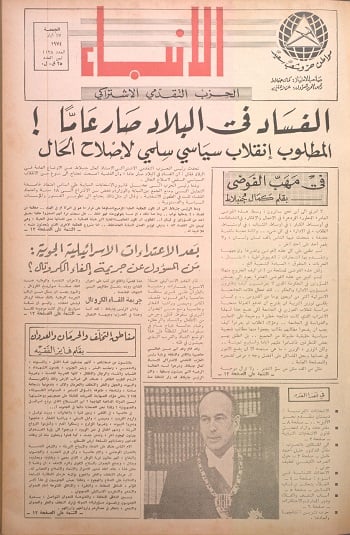6 Ways to Rein In Today’s Toxic Monopolies
By Stacy Mitchell/ The Nation
21 فبراير 2018

It’s an age-old question, a cliché so apt it never gets old: What is to be done?
After nearly four decades of lax antitrust policy, during which a handful of corporations have been allowed to gobble up market share like a horde of deranged amoebas, the consequences of unfettered monopoly have become painfully apparent. Competition has fizzled, replaced by pockets of extreme concentration. The number of new businesses has plunged. Wages have stagnated. Inequality has spiked. And extreme wealth—alongside its evil twin, extreme power—has pooled in fewer and fewer hands.
Mercifully, smart minds have been busy mulling smart solutions, brainstorming ways to begin reining in today’s mega-monopolies. Here are six suggestions.
1. Hold field hearings on the impact of concentrated economic power
Many Americans feel the consequences of monopoly in their daily lives. Nurses in Michigan saw their income depressed by an estimated 20 percent as a result of alleged collusion among dominant hospitals seeking to keep labor costs low. Dairy farmers in the Southeast contend they have been denied a fair price for their milk by two dominant firms that control the processing and distribution of milk. Independent pharmacists say that CVS Health, which manages prescription benefits on behalf of many insurers, has been abusing that power to reduce reimbursement rates for local pharmacists, with an eye to putting them out of business. Air travelers in the United States continue to pay inflated ticket prices, even as the cost of jet fuel, a major expense for the airlines, has fallen by more than half since 2014.
It’s no wonder that about two-thirds of Americans believe the economic system “unfairly favors powerful interests.”
That sentiment should prompt members of Congress to organize regional field hearings to investigate the real-world impacts of concentrated economic power and engage citizens in a conversation about what to do about it.
For inspiration, they might draw on hearings held in the late 1930s by what newspapers at the time often referred to as the “Monopoly Committee.” Officially named the Temporary National Economic Committee, it had been established jointly by Congress and the Roosevelt administration to investigate the causes and effects of concentration. The committee heard testimony from 552 people over a three-year period, and its findings laid the groundwork for stepped up antitrust enforcement for years to come.
2. Bring daylight to the nation’s antitrust agencies
Both the Department of Justice (DOJ) and the Federal Trade Commission (FTC)—the two agencies that share the task of enforcing US antitrust laws—regularly close investigations and approve mergers without offering any explanation to the public. In 2012, for example, Obama’s DOJ closed a three-year investigation of the agricultural-chemical producer Monsanto—a case closely followed in rural America—without issuing a statement. Nor did the DOJ explain its reasons, in 2013, for abruptly reversing course on the merger of US Airways and American Airlines, initially suing to block the merger, and then, a few months later, okaying it with only minor concessions from the companies.
Moreover, it’s only because of an inadvertent disclosure of documents to The Wall Street Journal a few years ago that we know that officials at the FTC concluded in 2012 that Google was abusing its monopoly power in ways that had resulted “in real harm to consumers and to innovation in the online search and advertising markets.” Staff from the agency’s competition division had recommended that the FTC file suit against the company, but the agency’s commissioners voted against that recommendation—and kept the public in the dark about the fact that it had been made.
Antitrust policy has been allowed to slip into the bureaucratic shadows, becoming the domain of a small cadre of people. It now suffers from what the scholars Harry First and Spencer Weber Waller have described as a debilitating “democracy deficit.”
It wasn’t always this way. When Franklin Roosevelt decided, in his second term, that restoring prosperity would require breaking the grip of dominant corporations, he hired a spirited lawyer from Wyoming named Thurman Arnold to run the DOJ’s Antitrust Division. Arnold believed that, to take on titans like Dupont and Alcoa, he would need to build broad support for the agency’s mission. Soon after taking the job, he made the case for stepped-up action against monopolies in an essay penned for his fellow citizens and published in The New York Times Magazine. Under his direction, the division opened regional offices across the country to uncover antitrust violations, and it began issuing detailed public statements with every case it prosecuted. Within two years, the division’s caseload had grown eightfold and its activities were regularly covered by the news media.
3. Set a higher bar for approving mergers
About three-quarters of industries are more concentrated than they were 20 years ago, and much of this increase has been fueled by mergers. The tipping point came in 1982, when Ronald Reagan’s DOJ adopted new guidelines for reviewing mergers. Prior to this, the DOJ’s merger guidelines had focused on market structure, and embodied the idea that having many competitors in an industry generally produced the best outcomes. The guidelines even stipulated specific market-share thresholds that would generally cause a merger to be opposed by the government.
The 1982 guidelines represented a radical change in thinking. They were the culmination of an ideological movement led by Robert Bork, a prominent legal scholar and Nixon’s solicitor general. Bork believed that the only aim of antitrust policy should be maximizing efficiency, which would lead to lower prices. His “consumer welfare standard” has been the centerpiece of merger policy ever since, embraced by both Democratic and Republican administrations.
As a consequence, merger reviews have become highly technical affairs, hinging on complex economic analyses. If the corporations involved can show that the merger will produce efficiencies that open the way for lower prices, then their marriage plans generally win the DOJ’s blessing.
As it turns out, however, these economic models are not very good at predicting future prices. John Kwoka, an economics professor at Northeastern University, recently studied the outcomes of dozens of major mergers. In 75 to 80 percent of the cases, he found, they had led to sizable price increases. Meanwhile, new scholarship has concluded that rising concentration is pushing down wages and causing other problems, like widening geographic disparities, that current merger-review policy sidelines as irrelevant considerations.
It’s time to dump Bork’s consumer-welfare standard and bring back an approach to reviewing mergers that recognizes that promoting competition, not efficiency, best serves the public interest. Altering the merger guidelines is something a future administration could do—as could the current one, at least in theory—and the idea is beginning to find some traction. Last year, the Democratic Party released a platform of proposals that included creating new standards for reviewing mergers. And in December, the Senate’s bipartisan Antitrust Subcommittee held a hearing on whether the consumer-welfare standard is outdated. Although four of the five invited witnesses, including two conservatives and two liberals, argued for keeping it (though they differed on whether to enforce it with more vigor), that the discussion took place at all was nevertheless a breakthrough.
4. Break up Big Tech
Google, Facebook, and Amazon pose such a fundamental threat to American democracy that the only rational solution is to break them up.
These companies command markets to a degree that makes agribusiness and airline giants seem meek by comparison. Google controls 92 percent of internet searches. Last year, Google and Facebook attracted an estimated 84 percent of global spending on digital advertising, excluding China. Amazon owns over 70 percent of the market for e-books and, through the spread of Alexa, 71 percent of the in-home voice market.
One reason these pervasive digital platforms constitute an existential danger is that they control the fates of so many other businesses. Retailers and manufacturers at once compete with Amazon and depend on it to reach the market. Media companies are beholden to the algorithms of Facebook and Google. Google has used its control of search to privilege its own travel and shopping services, while marginalizing those of rivals. In 2013, Facebook bought a tiny start-up, Onavo, and used its technology to spy on smartphone users as a way to detect popular new apps early and then either buy them or copy their functionality.
A second reason these firms have become dangerous is that they control the flow of ideas and information—an arrangement no democracy can tolerate. They mediate our interactions, and they decide which sites show up when we search; which news stories, real and fake, we encounter in our feeds; and which books we run across. Surveillance is a central strategy of all three of these tech monopolies. And they all use the extensive data they’ve gathered about us to hinder upstart competitors, keep us tuned into their services, and otherwise sustain their dominant positions.
What would breaking up these companies look like? It would essentially mean removing the conflicts of interest at the heart of these digital giants by compelling them to spin off their platforms, which provide market access for other firms, from the other parts of their business that compete with those same firms.
That process would likely begin with an antitrust investigation. Last November, Missouri Attorney General Josh Hawley, a Republican, launched an antitrust investigation of Google. His office is looking at, among other things, whether Google manipulates search results to favor its own products over those of its competitors, in violation of the state’s antitrust laws. It would be a promising development if other state attorneys general, who have broad authority to protect their citizens from monopolies, did the same. Many of the nation’s most pivotal antitrust cases, including those that led to the break-up of Standard Oil and the almost-break-up of Microsoft, were first initiated by state investigations and later taken up by federal antitrust enforcers.
5. Block big corporations from using their financial might to crush smaller competitors
Today’s monopolists have found that they don’t have to out-compete their smaller competitors to gain market share. Instead, they can use their size and financial resources to muscle them aside.
Walmart, for instance, demands that, for 80 percent of the groceries it buys, suppliers offer it prices that are 15 percent lower than those they give to its competitors. And Walmart has such a commanding share of the nation’s grocery market that many suppliers feel they must comply. As a result, independent grocers and competing chains, even those buying at high volumes, pay more. Over time, they’ve lost ground to Walmart, which, in 2015, captured half of grocery sales in more than 40 metro areas.
Amazon, meanwhile, has routinely flexed another monopoly muscle available to deep-pocketed companies: selling goods below cost. When the online shoe retailer Zappos soared in popularity in the mid 2000s, Amazon began selling shoes at loss, eventually losing an estimated $150 million. The strategy worked: Unable to sustain similar money-losing prices, Zappos agreed to a merger. Today, Zappos is Amazon.
Amazon’s investors, content to forgo present returns for future market dominance, have happily supported this strategy, and the company has used it repeatedly. It bled money on diapers to capsize and eventually buy Quidsi, the firm behind Diapers.com, and for years, sold books at a loss to squeeze out competing booksellers.
US antitrust law technically bans this kind of behavior. Predatory pricing, or selling goods below cost with the intent of harming competition, is illegal under the Sherman Act, while price discrimination, achieved by demanding special discounts from suppliers, is prohibited by the Robinson-Patman Act. Congress passed the latter in 1936 in response to the growing power of the A&P grocery chain. The idea behind these laws was that companies should win by competing, not by using their financial resources to warp markets in their favor. And for a long time they worked: A&P grew to be a national grocer, but it never overwhelmed the food industry to the degree Walmart has.
What changed is that, in the 1980s, as the consumer welfare framework took hold, the US Supreme Court began to shift how it viewed predatory pricing and price discrimination cases. Consumers, the Court reasoned, were benefitting from lower prices. It therefore set an almost impossibly high bar for ruling against such behavior, even if it harmed competition. “While predatory pricing technically remains illegal, it is extremely difficult to win predatory pricing claims,” notes Lina Khan, a legal scholar with the Open Markets Institute.
Khan argues that the doctrine the Supreme Court adopted in the 1980s to analyze predatory pricing cases urgently needs to be revisited. This is especially true in light of “the economics of platform markets, where firms can sink money for years given unlimited investor backing.” That kind of shift in jurisprudence will take patient work by legal scholars, attorneys, and judges. But the good news is that that work has already begun, led by Khan and others.
6. Pass anti-monopoly policies at the local level
Antitrust policy is critically important, but it’s not the only way that public policy shapes the economy and structures markets. Nor is this policy-making capacity confined to the federal level. Cities and states can take significant steps to protect their citizens from monopolies, while dispersing opportunity and promoting competition. (My organization, the Institute for Local Self-Reliance, focuses on providing policy ideas to help them do so.)
A growing number of places are taking up the cause. In a statewide referendum in 2016, Oklahoma voters strongly favored a policy to check the power of large agribusiness. A few years ago, Jersey City capped how much space chain retailers may occupy in its downtown, as part of a broader effort that has led to the opening of hundreds of new local businesses. In 2014, the citizens of North Dakota voted overwhelmingly to keep their state’s pharmacy ownership law, which mandates that pharmacies be independently owned and has largely spared North Dakotans from the higher prices and other harms that the rest of the country is seeing as a result of concentration in the prescription benefits industry.
Cities are also sidestepping monopolies by creating their own public options. Half of US households have, at most, only one provider to choose from for high-speed Internet access. While the federal government has been content to let these monopolies maintain their chokehold, many municipalities have not been. Dozens have built their own publicly owned high-speed fiber networks. As a result, some of the country’s best Internet service is now found in out-of-the-way places, like Ammon, Idaho; and Wilson, North Carolina. And, unlike the private monopolies they compete with, these public options have no intention of abandoning net neutrality.
Scanning the country with this lens, it’s possible to trace the broad outlines of an anti-monopoly movement—one whose geography, it’s worth noting, suggests a latent potential to rearrange America’s divided electoral map. Right now, though, these scattered uprisings are not linked as part of a common cause.
Something similar was happening in 1920s and 1930s, another period of high levels of economic concentration, when farmers were challenging the power of Wall Street and small towns were fighting the grocery giant A&P. It was Franklin Roosevelt who helped people see that monopoly was the root problem. “Today we stand committed to the proposition that freedom is no half-and-half affair,” he said, as he accepted his party’s nomination for the presidency in 1936. “If the average citizen is guaranteed equal opportunity in the polling place, he must have equal opportunity in the market place.”
Today’s political leaders have an opening to do what Franklin did. It’s up to us to help them see and grasp that opportunity. We can do that by passing local laws to limit the reach of monopolies in our own communities and demanding transparency from the nation’s antitrust enforcers. Most important, we need to speak up about the ways monopoly is affecting our own lives—ideally at a series of congressional field hearings.
 عن أمل جنبلاط المتجدد: لبنان يستحق النضال
عن أمل جنبلاط المتجدد: لبنان يستحق النضال
 صحافيون أم عرّافون!
صحافيون أم عرّافون!
 ماذا يجري داخل أروقة بيت الكتائب المركزي؟
ماذا يجري داخل أروقة بيت الكتائب المركزي؟


 عن الخرائط التي تُرسم والإتفاقات التي تتساقط!
عن الخرائط التي تُرسم والإتفاقات التي تتساقط!
 “الإنحراف في الحياة”/ بقلم كمال جنبلاط
“الإنحراف في الحياة”/ بقلم كمال جنبلاط
 هاشتاغ #صار_الوقت يحل أولاً في حلقة جنبلاط
هاشتاغ #صار_الوقت يحل أولاً في حلقة جنبلاط
 طاولة نقاش عن أزمة الصحافة في جامعة AUST
طاولة نقاش عن أزمة الصحافة في جامعة AUST
 عبدالله: ليظهر لنا وزير مكافحة الفساد حرصه في صفقات البواخر والفيول
عبدالله: ليظهر لنا وزير مكافحة الفساد حرصه في صفقات البواخر والفيول
 عبدالله: غريب أمر وزارة مكافحة الفساد!
عبدالله: غريب أمر وزارة مكافحة الفساد!

 Comment to Uri Avnery: How Sad What Is Looming Ahead
Comment to Uri Avnery: How Sad What Is Looming Ahead
 “Not Enough!”
“Not Enough!”
 … لمن لم يقرأ يوسف البعيني/ بقلم وسام شيّا
… لمن لم يقرأ يوسف البعيني/ بقلم وسام شيّا
 كمال جنبلاط في مولده الأول بعد المائة: تعاليمه وأفكاره ما زالت الحلّ/بقلم عزيز المتني
كمال جنبلاط في مولده الأول بعد المائة: تعاليمه وأفكاره ما زالت الحلّ/بقلم عزيز المتني
 رئيس حزب/ وليس (… سابقاً)/ بقلم د. خليل احمد خليل
رئيس حزب/ وليس (… سابقاً)/ بقلم د. خليل احمد خليل
 التوازن السياسي في لبنان
التوازن السياسي في لبنان
 لبنان… مشاريع انقلابية مؤجلة
لبنان… مشاريع انقلابية مؤجلة
 جنبلاط وحَمَلة أختام الكاوتشوك
جنبلاط وحَمَلة أختام الكاوتشوك
 Le Liban est un symbole de tolérance
Le Liban est un symbole de tolérance
 Our Automated Future
Our Automated Future
 The True Origins of ISIS
The True Origins of ISIS
 Les Misérables vs. Macron
Les Misérables vs. Macron
 عذراً أيها المعلم/ بقلم مهج شعبان
عذراً أيها المعلم/ بقلم مهج شعبان
 رساله الى المعلم / بقلم ابو عاصم
رساله الى المعلم / بقلم ابو عاصم
 إلى روح القائد والمعلم كمال جنبلاط/ بقلم أنور الدبيسي
إلى روح القائد والمعلم كمال جنبلاط/ بقلم أنور الدبيسي
 أسرار وعناوين الصحف ليوم الجمعة 14 كانون الاول 2018
أسرار وعناوين الصحف ليوم الجمعة 14 كانون الاول 2018














